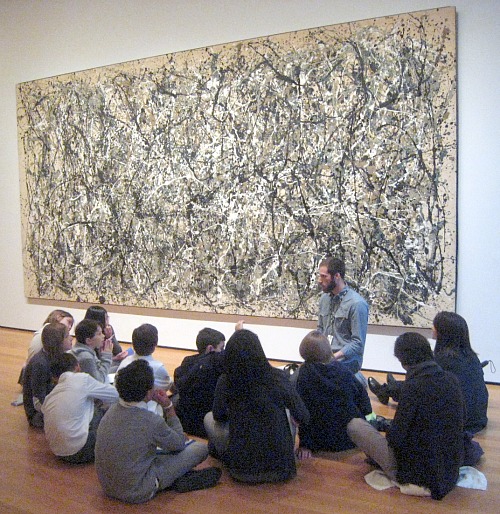
Fasten Your Seat Belts: The MoMA Syndrome Writ Large
The MoMA Syndrome, as previously identified on Artopia, is the reverse of the Stendahl Syndrome or is the Stendahl Syndrome inside-out. Instead of swooning when you actually see the glory of Florence, the MoMA Syndrome is defined by that sinking feeling of disappointment when victims see artworks previously known only through color reproductions or projections in a lecture hall. On John Perreault’s Artopia Facebook Group, I initiated what turned out to be a lively discussion on the topic, now archived on John Perreault’s The Artopian.
I called it the MoMA Syndrome because it sounds catchy and, after all, MoMA has the world’s biggest cache of modern-art masterpieces, which are, for better or worse, endlessly reproduced.
And now we have the MoMA Syndrome in full force at MoMA itself. “Abstract Expressionist New York” (to April 25) is a shocker. Most of the art on the walls looks better as high-wattage projection — bigger, brighter, bolder — or at the other end of the no-scale spectrum on a small computer screen, where the art pops. Maybe that is really what counts. Museum websites have more visitors than do their physical plants, which cost so much to climatize, guard, and tidy up. Real-world museums, especially in hard times, require more and more visitors just to stay abloat. Typo. I meant to say “afloat.”
We do not really want to address again the aura problem, so beloved by all since Walter Benjamin muddied the waters. Suffice it to say, photos and image projections have auras only to the degree that tin saints do. Which they do, in case you wondered. Unless aura is a substance — possible, but unlikely — my aura is not necessarily your aura; aura is in the eye of the beholder. Then too, to true believers or scientists of the occult, huge numbers of supplicants can impregnate objects with aura, or deplete them. The latter may be what has happened to too many of the paintings now occupying MoMA’s fourth-floor galleries. The false tooth of St. Joseph no longer performs miracles.
What to do about the MoMA Syndrome? How do you make dead artworks come alive? Maybe you can’t.

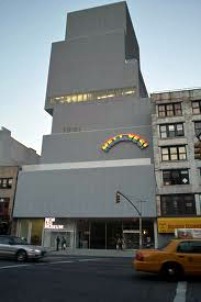
Which is more beautiful? Norman Foster’s Sperone Westwater Gallery or the New Museum? Which is best for showing art?
Art Migrations Now Possible
We know a lot of museums, unlike MoMA, are in trouble these days. Overbuilt, overextended, underfunded. It’s the economy; it’s the economy, Stupid. My suggestion is to rent out the spaces to haute-cuisine or special-event restaurants and/or as flagship platforms for high-end clothing designers. And then migrate to the internet.
I don’t really know if the New Museum, for instance, is in danger. I hope not. But if so and I were the director or a trustee, I would seriously consider such a “daring” migration to the internet. Wouldn’t that be avant-garde and truly contemporary?
Now that the Sperone Westwater Gallery has opened its Norman Foster building in the Lower East Side (!) on The Bowery , there should be a better use for the nearby New Museum building — which cannot hold a candle to that multi-story delight a block away. Every modest floor of Sperone Westwater is perfectly proportioned, which cannot be said of the inexplicably prize-winning New Mu.
Therefore, let’s re-imagine the New Museum of Contemporary art as an online museum of new art made for the internet, with a collection of same — cloud-stored, eternal, with free access for all worldwide. Renting out the current physical plant to Comme des Garçons or Nike would provide the nut, the initial startup costs and perhaps the continual upkeep.
Aside: I have already noted on Facebook and Twitter that the Whitney has sold off eight of its buildings on Madison Avenue to fund its strange migration to the foot of the High Line in the Meatpacking District. What will happen to the iconic Marcel Breuer building? I suggest that dealer Larry Gagosian buy it to mount his museum-quality exhibitions. Contrary to one of the New York Times reviewers, it is still a perfectly splendid place to show art.
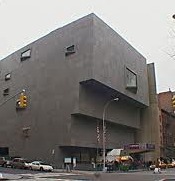
In the meantime…..
 Why We Love Our Mommy
Why We Love Our Mommy
If you are interested in art and the direction art might now pursue, if you are interested in culture, if you are interested in history and literature, if you are interested in institutional critique, you must see MoMA’s Abstract Expressionist New York — in spite of most of the paintings and nearly all of the sculptures.
This is a dull exhibition and quite possibly a bad one, but it is essential. And the following will explain what I mean.
First the Bad News
More than half the work is not very important or even very interesting. Have our eyes changed? Was the accession of this work helter-skelter, or is this selection from the MoMA trove too generous? Is the trove not such a treasure trove after all?
Even some of the big works end up looking like doll-house decorations. The art has not become smaller; the world is bigger. You would think it would be the reverse. If art has anything to do with life, than three-quarters of the paintings and almost all of the sculptures here appear to be about the search for style and not really much about life as we know it.
Of course, when you come across Pollock, de Kooning, Newman, Rothko, and Reinhardt, you are in another universe almost by default. Maybe that’s the point. Show the dull work to make the masterpieces shine?
I was hoping to say that Ab Ex was about the struggle and not the product. No such luck. Most of the artists may have thought they were changing the world, or at least trying to express their emotions, their hopes and frustrations, but in concert it looks as if they were only changing the art market. Their hopes and frustrations long ago left the room, perhaps when Cinemascope and Cinerama quickly trumpeted the biggest of Jackson Pollock’s drip paintings. Movies were the portable murals he wanted to make.
Aside from labels nobody ever reads, some mild context and scene-setting is provided by drawings, prints, books, and ephemera relegated to the side shows on other floors. Consequently helpful information is not integrated into the experience of the art. Poetry? Music? Although appropriate, Charlie Parker as a sound context might upstage the art. Frank O’Hara chatting about this and that and what he had for lunch? You can’t win at this sort of thing. What would I have tried? An entrance room that bathed the viewer in images: Great Depression relief lines, concentration camp footage, Hitler’s speeches, the signing of the Hitler-Stalin Pact, the atomic bomb. All the things the artists were trying to repress, and at least one of the critics (Clement Greenberg), too.
Here, however, it’s business as usual.
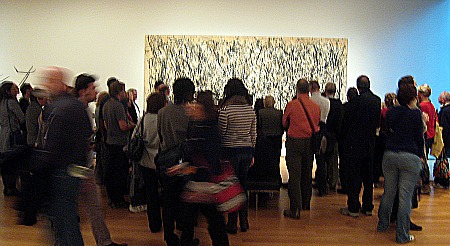
And the Bad News Goes On and On
Too many paintings are jammed into each room. I remember that Picasso’s Guernica, when it was in the protective custody of MoMA, had a room to itself. Shouldn’t the same be true now for the big Pollock and the big Newman, even in a temporary exhibition?
I don’t want to knock off the bad paintings one by one, for that would make tiresome reading. But before I entertain you with potshots, I can’t resist at least one big “for instance” because it is so exhilarating to see an art saint brought down to earth. Three top-of-the-line all-black Reinhardts are displayed with some of the worst paintings he ever made. There’s a reason we know him for black and not for red or blue. Maybe the idea was to bring these disasters into the MoMA collection in order to take them off the market!
On the other hand, one is pleased that Helen Frankenthaler is nearly invisible, although I would have rejoiced even more if she had been omitted entirely. She belongs to the sociology of art and not the history of art. It is ironic that someone so dependent upon the largesse of an art historian (her husband Robert Motherwell) and her biggest and possibly only art-critic fan (Greenberg) should have so boldly pressed for the elimination of the National Endowment for the Arts fellowships for art critics. She won that one, but lost the world.
However, it pains me to say that works by Elaine de Kooning and Lee Krasner should also have been eliminated. It’s awful stuff. One can only hope that somewhere in the universe there are better Elaine de Koonings and better Lee Krasners than the examples that have been parked in the MoMA permanent collection.
Are there no great women Abstract Expressionists? I’d vote for Joan Mitchell, but here there is only one painting.
I certainly would have left out Larry Rivers. As I have pointed out on a previous Artopia post his work has a certain charm. But, although he had a sociological connection to the rest of the boys, his 1953 George Washington Crossing the Delaware sticks out like a sore thumb. Robert Motherwell’s work simply does not hold up. His paintings have no depth. But at least one Hans Hofmann looks better than expected, which is refreshing because the Ab Ex artists themselves thought of him as a major influence as the movement unfurled. Plus, his small drip-painting precedes Pollock’s. Did Pollock ever see it? Was it shown anywhere?
* * *
Now that I think of it, another artist who should have been eliminated is Louise Nevelson. What is she doing here anyway? Those totems and boxes and stacks have not worn well. She was never seen as an Abstract Expressionist, in any case. And surely wasn’t one. She is a latter-day Cubist.
But in my view all the sculpture on the fourth floor should be done away with. Even David Smith? Yes, even David Smith. The work included here reeks of Picasso. In fact, except for the Noguchi and the in the side-show called “Ideas Not Theories” all of the sculpture should have been eliminated. Dull, dull. Abstract Expressionist sculpture might require an exhibition of its own, but I won’t visit that one.
Icarus or Oedipus?
Film noir was not about the tough women who lived through World War II and turned out too strong, two threatening, too emasculating, and too deceptive. That is the “screen memory,” as Freud might have said: the false memory that disguises what really is at stake. The real theme in film noir is weak men; men who are saps. Men who fought in a war they did not understand. Men in the trenches who thought their wives back home would be loyal. Men who came home and voted for Dwight D. Eisenhower. Think of the male leads in Double Indemnity and Mildred Pierce. They are fools. Those White Goddesses on the silver screen eat them alive, and the men like it.
It could be that de Kooning had started an art movement of his own, for once he began his angry White Goddess paintings, he was going in a different direction from Pollock, Newman and Rothko. De Kooning at his grandest, most daring and most angry led to Pop.
Otherwise he attracted and influenced the insouciance of such painters as Jane Freilicher, Fairfield Porter, and Rivers. They sopped up the charm of the man in real life, while avoiding the anger. He himself managed to mix charm and anger, which is like the miracle of mixing oil and water.
His true heirs were not Michael Goldberg, Kline, or Alfred Leslie (all thought to be so at one time) but Robert Rauschenberg and Alice Neel. One cannot imagine her late paintings coming into existence without her knowing side-glance at de Kooning. De Kooning was realism’s undercover man. He himself needed an image to cue his paint-handling. And he had no interest in portable murals.
Later Leslie, once de Kooning’s most promising heir-apparent, would take care of that when he turned to full-fledged representation and produced the portable murals that memorialize poet O’Hara, a de Kooning friend and a curator at MoMA. O’Hara was runover by a beach taxi one night on Fire Island, between Water Island and The Pines. Here, of course, Leslie is represented by one of his splashy, show-off abstractions.
But there I go again, curating a show out of the ashes of an existing effort. My exhibition would separate out “De Kooning and His Descendents.” The whole shebang needs to be re-aligned. There is about as much connection between de Kooning and Pollock as there is between Picasso and Braque. The connections are all on the surface. Just because Bill and Jackson knew some of the same people and threw up in the same bar doesn’t make them bedfellows.
A case could be that they were merely how the star art critics of the period — Greenberg and Harold Rosenberg – fought it out, using the two painters as their personal avatars. Not Hindu avatars, but more like present-day videogame puppets.
And where does Kline fit? Well, judging by the paintings here, nowhere. They are weak and lack spatial tension. In fact, they look oddly flat. They have become flaccid with age. All the other guys might have really loved him the way they loved David Smith, but now the truth can be told. He may have been a man’s man, but he really wasn’t much of a painter.
Unlike the best paintings by Pollock, de Kooning, Newman, and Rothko, Kline’s no longer looks bigger than life. The drama, such as it is, is all squashed girders. At least his paintings are badly designed, whereas the Motherwells are well-designed and even less interesting.
* * *
And the artist to beat was:
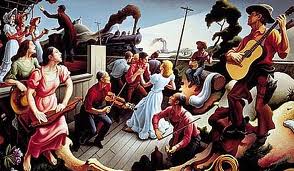
or
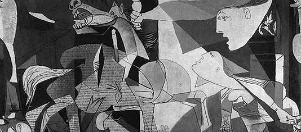
or

The Long Winding Road to Transcendence
The build-up in life was long and tedious — even for Pollock and de Kooning. How do you beat Cubism? How do you upstage Paris? Jackson thought the artist to beat was his teacher Thomas Hart Benton. Was our hero an idiot?
Benton was an anti-modernist homophobe from Missouri. And a blind homophobe at that: One of his Regionalists comrades was the very queer Grant Wood. Or maybe what happens at home stays at home. Or maybe — I am being bad — Benton was bent himself and was a camoufleur in more ways than one.
During WWI he made paintings of camouflaged ships to make sure the camouflage was correctly applied and to keep a record of same. He once said that the work he did in the Navy was “the most important thing, so far, I had ever done for myself as an artist.”
At least de Kooning knew that it was Picasso you had to beat, not Benton, who was sort of a leftist but made his mark with his folksy, crypto-Fascist, back-to-the-soil murals and attacking the homo New York art world. Truly a creep.
And Newman and Rothko and Reinhardt knew full well they were up against Mondrian.
That Pollock stupidly though that Benton was the man to beat was more Oedipal than awful. After all, Benton and his wife had been exceptionally kind to him when he was the master’s pupil at the Art Students League.
Oh, but he was a handsome dude, that Jackson. As was de Kooning. Some of my women friends complain that you have to be beautiful to be a successful woman artist. Or complain that no one takes you seriously if you are beautiful, as Hannah Wilke always whined. Sorry. In comparison, even Jeff Koons knows men have to be handsome too. What a cross to bear.
In comparison to Pollock (the older brother you would hate), I offer Newman – the avuncular intellectual and the man who in 1933 ran for mayor of New York. He wanted “more extensive education, a greater emphasis upon the arts and crafts, and the fostering of cultural living conditions.” In his manifesto (On the Need for Political Action by Men of Culture) he called for “a clean air department, “a department of local waters to clean up the beaches and rivers,” “low price park casinos,” and “a large indoor and outdoor public forum free of police licensing.”
I’d vote for that.
What else was going on in 1933. Here’s an amusing and illuminating accounting via my new favorite resource, warholstars.org, produced and compiled by Londoner Gary Comenas: 1933.
Please pay attention: backgrounding and contextualizing doesn’t have to be dull.
And take a look at the Comenas list for 1948, the year Newman produced his first “zip” painting and Pollock first showed his “drip” paintings at the Betty Parsons Gallery.
The odd thing about Pollock — who, even de Kooning agreed, “broke the ice” –is that he tapped the van Gogh/Icarus archetype and was able to make a few heroic paintings. His closest rival was not really de Kooning (who had a different mythology, that of The White Goddess) but Barnett Newman.
Here, in Hans Namuth’s documentary, is Pollock speaking for himself:
Newman was too wise to fall into the Icarus trap and yet managed to produce heroic paintings of his own. I am not sure what archetype Newman fits, possible that of the Wise Old Man or even Trickster.
Here is Newman:
We need a third Ab Ex demiurge. (How we love that blessed trinity we can even see in the Kabbalah, much admired by Newman.) Gottlieb? No, I’d vote for Rothko with his mist of doom, the not-so-rosy dawn of holocaust. The Voice of G-d made palpable; like frozen light over a poisonous sea.
In discussing Ab Ex I am forced to use Jungian references. Ab Ex was under Jung’s thumb. But also — and this is something even more important – under the sign of the apocalypse Could there be any doubt that the world as once known had come to an end?
Take away apocalypse and you have the empty canvas. We are not in the company of Guernica but with the empty-headed hedonist Matisse working under Vichy, selling his paintings out of his studio and in commercial galleries to Nazi officers. All he needed to be happy, he said after the war, was his canvas, his easel, brushes, tubes of paint, sunlight and a beautiful view.
As opposed to:

Barnett Newman: Vir Heroicus Sublimus (1950-52)
And Now the Good News….
The importance of this exhibition has nothing to do with whether particular artworks are good or bad. You can, if you must, have fun with that at a dinner party, starting with the Artopia score-sheet above. But the point is that you have already seen the two great Pollocks, the two great Newmans, and the two great Rothkos. Why go for more and risk being punished? Because….
(1) “Ab Ex New York” at MoMA tells the story of an institutional failure of taste over time and should provide or result in correctives.
If this had been made clear, the Ab Ex sampler would be sensational. We could have a timeline with little thumbnails of paintings acquired, how, and from whom. And who served on the acquisitions committee. With their biographies…
X painting was donated by Y and approved by an acquisitions committee made up of Z, W, P, etc….. X at the time owned an R or similar paintings, as did Z, W and P.
But do we want that kind of transparency? Do we need to break the illusion that whatever is in a museum collection represents some kind of objectivity? Can these decisions ever be objective?
And then there will be mysterious, beyond-comprehension acquisitions such as: Z gave a T, which the curators and/or the committee desperately wanted, but only on condition that inferior paintings by W and Z would also be acquired. How would we ever find that out? It’s doubtful that this kind of thing would be in the minutes. You cannot quite put a wink-wink into words. Wink-wink is a technical term for: “You know what I want so I don’t have to say it because my being here says it.”
More Good News: Apocalypse Now
(2.) In spite of its failures, “Ab Ex NY” makes us mourn for a time when art was important, even to artists.
Many things are wrong, wrong, wrong with Ab Ex NY. Nevertheless, it could, if viewed properly, act as an antidote to the rampant superficiality of much current art, most of which does not have even have the heroic superficiality of Pop Art proper — exempting Koons and Hirst, who if nothing else are certainly heroically superficial. You cannot fault them on that. Alas everything else is a regurgitation of almost everything that came before. I think the word is academic. Everything is Neo-Pop. Everything is pap.
So can the Abstract Expressionist moment be repeated? Do we have anything to be angry about? Maybe we are lucky that 9/11 is fading away, that global warming is infinitely sneaky and that somehow we have not internalized that the killing off of the coral in the oceans is worst than the BP oil disaster, which was bad enough. Can you be heroic about the silent passing of billions of little worms whose only task in life is to build reefs to protect bits of paradise? Can we be angry that as the ocean rises and the Long Island second homes of Charlie Rose, Isabella Rossellini, and too many art dealers to mention will be underwater? That my partner and I will unexpectedly have waterfront property?
Something dire is afoot. Why else would the government be spending so much money looking for planets like Earth? Planets that could support human life. Are we planning to migrate?
But you don’t need atom bombs and ecological disasters to be heroic and/or to seek the sublime. You just need to remember Man’s fate. We live so briefly and then we die, usually leaving nothing much behind, maybe a grandchild or niece and nephew here and there representing a further dilution of the gene pool, tilting more and more to idiocy. Maybe a condo on the ocean and that condo will eventually fall into the sea. And certainly a lot of bills. Even good deeds go the way of all flesh.
This does not mean that in art we should revive existentialism. Perish the thought. Or the wilder shores of Jung — who, in any case is too far to the right for most of us now. But can’t we have art that is about something more than the integrity of the picture plane? About more than other art? Or about more than popular culture?

Walser’s Corpse
If you are armed with the thesis that there were sociological and even spiritual issues at the core of Ab Ex, you will be the better for it. You might come closer to the art. Viewing the sideshows prior to seeing the main attraction and carefully reading the labels will be of some help, but basically we are presented with standard formalism. Meanings disappear under the weight – or the lack of weight — of the “purely” visual. And why?
Because to delve into the richness of context would reveal the rage and the politics behind it all. Uncle Clem, for instance, formerly a leftist, moved further and further right and was perhaps too cozy with money and power. The notion came about that Ab Ex, coming under the wing of the State Department foreign exhibitions program, the United States Information Agency and some say the C.I.A., could demonstrate to the world the virtues of American democracy.
Although her husband John D. Jr., son of the founder of Standard Oil, hated modern art, Abby Rockefeller co-founded MoMA in 1928. Their son Nelson became president of the board of MoMA in 1939, succeeded in 1958 by their other son, John D. Jr., when Nelson was elected governor of New York.
I am not saying that there is anything wrong with calling attention to the surface of paintings and the interplay of forms. In fact, formalism, like math, can be illuminating and fun. Anyone can play. But we should not use it to reduce art to surface or push-and-pull. Formalism is the easy path. You only get what you see.
We who have one foot in the art world and the other in the literary world — one foot in heaven and the other in hell — have an advantage. We know what terrible damage New Criticism, promoted by the otherwise great poet T.S. Eliot (The Waste Land), did to poetry. New Criticism, to simplify, is the literary version of art formalism. Same family, same politics: deeply conservative all the way down.
Is it better to be formally correct than politically wrong? The Hitler-Stalin Pact confused everyone, including my own father. Alice Neel, at least in conversation with me, remained loyal to Stalin and The Party. How could she? I wanted to shout. But it would have done no good, because I knew her answer: consider the alternatives, John. Instead, I just reminded her that my great-uncle had been an organizer for the International Workers of the World. I have Wobblie blood in my veins.
See what happens when you believe in social justice? You are going to end up in chains, standing in line for three days without food or water in order to get a free vaccination at the state-run hospital. That’s what my father might have said in 1948 and until the day he died, even though as a wee lad I found a copy of Maxim Gorki’s Dialectical Materialism and James Joyce’s Ulysses hidden at the bottom of his bedroom closet. I was precocious; I immediately turned to Molly Bloom’s sex monologue at the end of the novel. I wasn’t interested in the sex, but I sure liked the writing.
So you see, we are talking Cold War here, too. Not just two-tone cars, James Dean and rock ‘n’ roll, not just espresso bars and TV. We are talking Senator Joseph McCarthy.
* * *
Let us try to remember that Jackson Pollock was consumed by rage, no matter how cool he appears in Hans Namuth’s documentary. He nearly starved to death during the Great Depression. De Kooning may have been even more tortured, but, you know, he had been born in Europe. He didn’t experience the Prairies. He didn’t feel the pain of cowboy boots. He drank as much, if not more, than Jackson but he knew better than to drive a convertible with two dames at his side, roaring between the potato fields of the Hamptons to catch a party on the North Fork, roaring to his doom.
De Kooning was angry at his mom and maybe all women; he feared being eaten alive by Robert Graves’ White Goddess and simultaneously he was that Big Mom’s biggest fan.
Newman, Rothko, Reinhardt, Gottlieb, and Richard Pousette-Dart were all mystics of some sort, which I think drove Uncle Clem crazy. Pollock favored Theosophy. You can make the man turn away from dialectical materialism, but you can’t take the materialism out of the man.
The art is the man (or the woman).
Can you read super-loner, Swiss writer Robert Walser (beloved by Kafka and Walter Benjamin and now by moi) shorn of the information that he was incorrectly diagnosed as schizophrenic and retired to a mental institution for the last 27 years of his life, either scribbling away on scraps of paper using a tiny script (resulting in six volumes of prose now fully deciphered) or silently, motionlessly standing upright in a corner? And that he died outside the asylum, face-down in the snow in 1956, echoing an image from one of his early novels, and that his corpse was photographed in this position? No, you can’t.
On the other hand, you shouldn’t reduce everything to biography or legend. You need the Universal Solution. You need the Artopia Braid: everything intertwined, moving in and out, over and under, through time. You need, as John Cage once said, at least five things going on at once.
FOR AN AUTOMATIC ARTOPIA ALERT E-MAIL perreault@aol.com
NEVER MISS AN ARTOPIA ESSAY AGAIN!
John Perreault is on Facebook.
You can also follow John Perreault on Twitter: johnperreault
